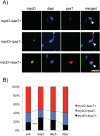Characteristics of myogenic response and ankle torque recovery after lengthening contraction-induced rat gastrocnemius injury
- PMID: 23110577
- PMCID: PMC3566911
- DOI: 10.1186/1471-2474-13-211
Characteristics of myogenic response and ankle torque recovery after lengthening contraction-induced rat gastrocnemius injury
Abstract
Background: Although muscle dysfunction caused by unfamiliar lengthening contraction is one of most important issues in sports medicine, there is little known about the molecular events on regeneration process. The purpose of this study was to investigate the temporal and spatial expression patterns of myogenin, myoD, pax7, and myostatin after acute lengthening contraction (LC)-induced injury in the rat hindlimb.
Methods: We employed our originally developed device with LC in rat gastrocnemius muscle (n = 24). Male Wistar rats were anesthetized with isoflurane (aspiration rate, 450 ml/min, concentration, 2.0%). The triceps surae muscle of the right hindlimb was then electrically stimulated with forced isokinetic dorsi-flexion (180°/sec and from 0 to 45°). Tissue contents of myoD, myogenin, pax7, myostatin were measured by western blotting and localizations of myoD and pax7 was measured by immunohistochemistry. After measuring isometric tetanic torque, a single bout of LC was performed in vivo.
Results: The torque was significantly decreased on days 2 and 5 as compared to the pre-treatment value, and recovered by day 7. The content of myoD and pax7 showed significant increases on day 2. Myogenin showed an increase from day 2 to 5. Myostatin on days 5 and 7 were significantly increased. Immunohistochemical analysis showed that myoD-positive/pax7-positive cells increased on day 2, suggesting that activated satellite cells play a role in the destruction and the early recovery phases.
Conclusion: We, thus, conclude that myogenic events associate with torque recovery after LC-induced injury.
Figures




Similar articles
-
Satellite cell activity in muscle regeneration after contusion in rats.Clin Exp Pharmacol Physiol. 2010 Nov;37(11):1078-86. doi: 10.1111/j.1440-1681.2010.05439.x. Clin Exp Pharmacol Physiol. 2010. PMID: 20726992
-
Detection of multiple biomarkers associated with satellite cell fate in the contused skeletal muscle of rats for wound age estimation.Int J Legal Med. 2023 May;137(3):875-886. doi: 10.1007/s00414-023-02971-w. Epub 2023 Feb 17. Int J Legal Med. 2023. PMID: 36797435
-
MyoD and myogenin protein expression in skeletal muscles of senile rats.Cell Tissue Res. 2003 Mar;311(3):401-16. doi: 10.1007/s00441-002-0686-9. Epub 2003 Feb 18. Cell Tissue Res. 2003. PMID: 12658448
-
Function of the myogenic regulatory factors Myf5, MyoD, Myogenin and MRF4 in skeletal muscle, satellite cells and regenerative myogenesis.Semin Cell Dev Biol. 2017 Dec;72:19-32. doi: 10.1016/j.semcdb.2017.11.011. Epub 2017 Nov 15. Semin Cell Dev Biol. 2017. PMID: 29127046 Review.
-
Epigenetic regulation of satellite cell activation during muscle regeneration.Stem Cell Res Ther. 2011 Apr 19;2(2):18. doi: 10.1186/scrt59. Stem Cell Res Ther. 2011. PMID: 21542881 Free PMC article. Review.
References
-
- Clarkson PM, Nosaka K, Braun B. Muscle function after exercise-induced muscle damage and rapid adaptation. Med Sci Sports Exerc. 1992;24(5):512–520. - PubMed
-
- Nosaka K, Clarkson PM. Muscle damage following repeated bouts of high force eccentric exercise. Med Sci Sports Exerc. 1995;27(9):1263–1269. - PubMed
-
- Garrett WE Jr. Muscle strain injuries. Am J Sports Med. 1996;24(6 Suppl):S2–S8. - PubMed
-
- Zarins B, Ciullo JV. Acute muscle and tendon injuries in athletes. Clin Sports Med. 1983;2(1):167–182. - PubMed
Publication types
MeSH terms
Substances
LinkOut - more resources
Full Text Sources
Medical

